倒伞型曝气机有限元分析及优化设计【含CAD图纸、UG三维模型】
收藏
资源目录

压缩包内文档预览:
编号:13252397
类型:共享资源
大小:17.16MB
格式:ZIP
上传时间:2019-01-13
上传人:机****料
认证信息
个人认证
高**(实名认证)
河南
IP属地:河南
50
积分
- 关 键 词:
-
含CAD图纸、UG三维模型
倒伞型曝气机
有限元分析
优化
设计
cad
图纸
ug
三维
模型
- 资源描述:
-
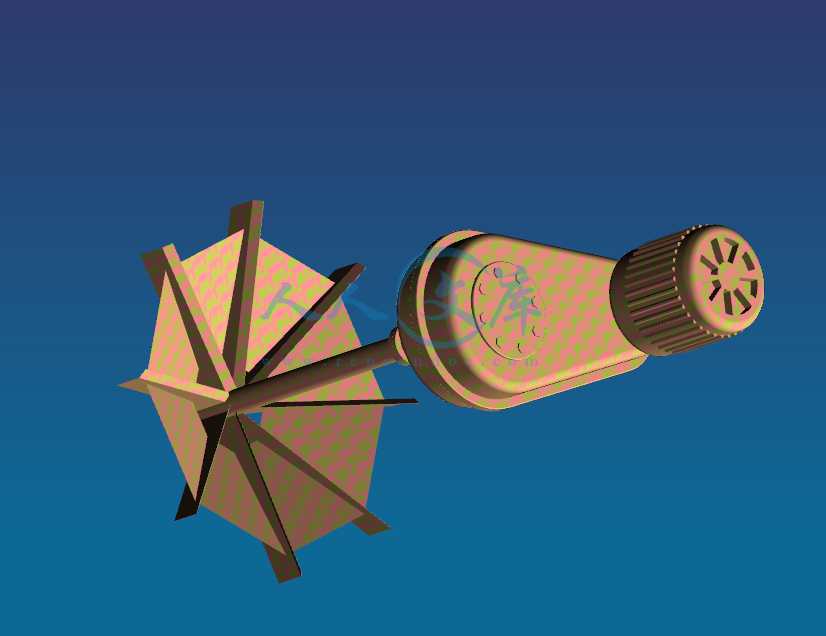

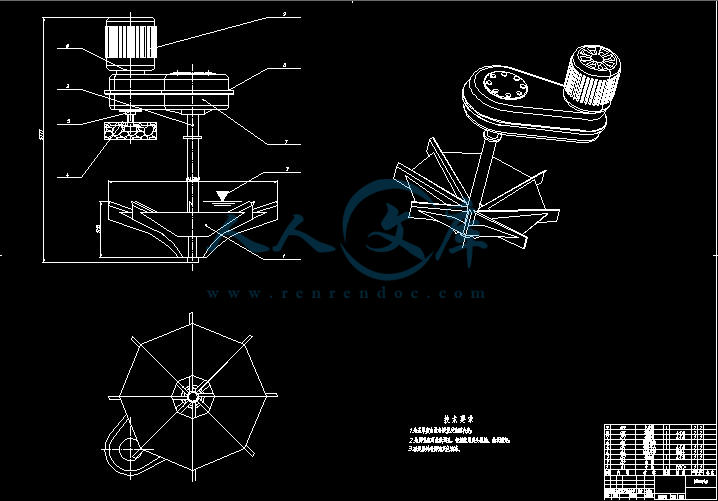
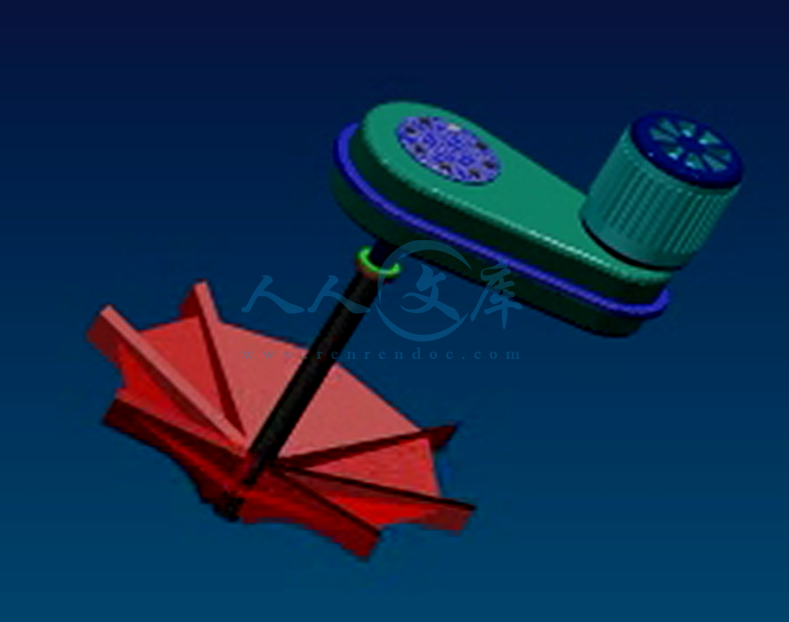

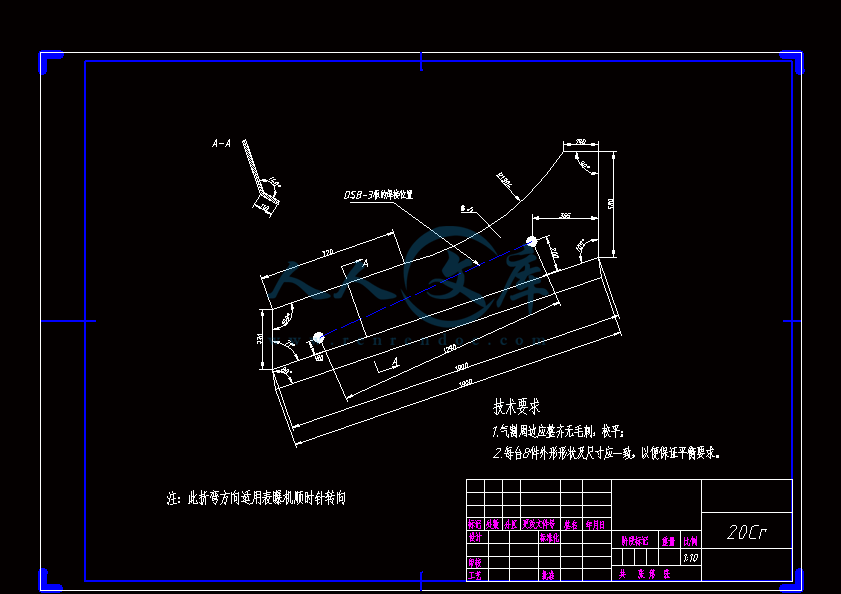
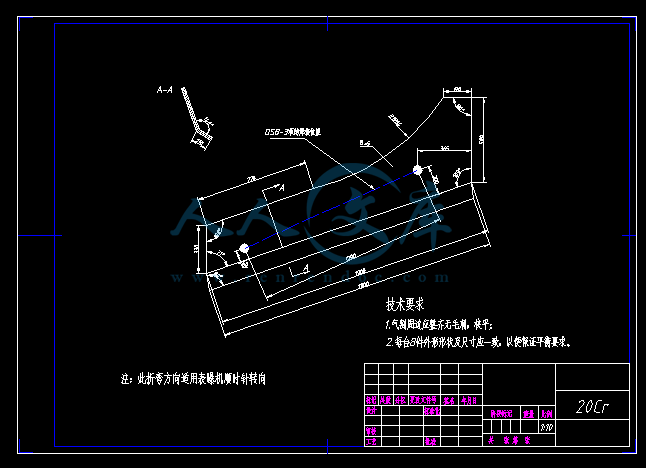


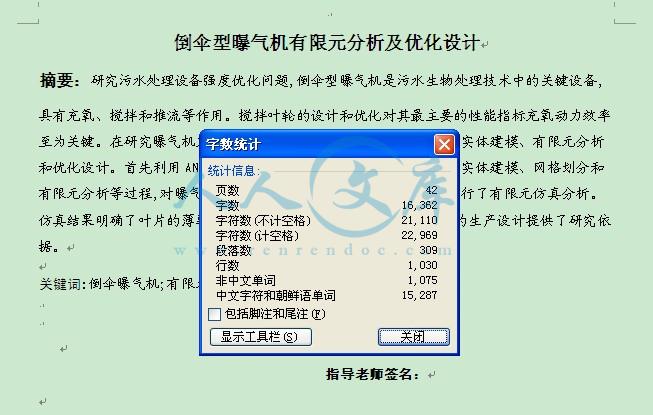
- 内容简介:
-
90 Chem. Educator 2002, 7, 9095 Assembly of a Multiphase Bioreactor for Laboratory Demonstrations: Study of the Oxygen-Transfer Efficiency in Activated Sludge Fernando Dorado*, Manuel Andrs Rodrigo, and Isaac Asencio Department of Chemical Engineering, University of Castilla-La Mancha, Campus Universitario s/n, 13004 Ciudad Real, Spain, fdoradoinqu-cr.uclm.es Received October 11, 2001. Accepted January 22, 2002 Abstract: A simple experimental device has been assembled with the aim of increasing students understanding of multiphase reactors and to highlight the importance of economic considerations in real chemical engineering problems. The multiphase reactor studied is an activated sludge reactor. In this type of reactor, organic matter and nitrogen substrates, which are contained in wastewater, are oxidized by solid bacterial groups that employ oxygen. Gas dispersion is a factor of critical importance in the operating performance and cost of every multiphase reactor. In the work covered here, students determine the influence of this factor on the assembly while considering that energy consumption (economic cost) depends on both the type of aerator used and the operational conditions for a given aerator. A theoretical model is proposed that allows the interpretation of the results based on the assumptions that gas absorption and biochemical reactions are the limiting steps. Experimental data are fitted to this model, and the parameters obtained allow comparison of the behavior of each type of aerator and also provide an understanding of the process. Introduction Multiphase reactors are reactors in which two or more phases are necessary to carry out the reaction. Types of multiphase reactors include slurry, trickle bed, and biological reactors and, in these systems, the reaction between the liquid and the gas phases takes place on a solid catalyst surface or on the surface of a bacterial group called biological floc. The Activated Sludge Process (ASP) is a typical example for this kind of system, and it is the main biological process occurring in secondary wastewater treatment. In this process, microorganisms oxidize organic (carbonaceous BOD) and nonoxidized nitrogen (total Kjeldahl nitrogen) substrates contained in wastewater and use the energy obtained in the process to form new microorganisms. As in every multiphase reactor, in the ASP the component transfer (oxygen transfer) between the injected gas bubble (air) and the solid phase (biological flocs) is a factor of critical importance. Thus, this parameter greatly influences the process performance and the operating cost 1, and currently its maximization is a research topic of major interest. The ASP is a good process to use in the study of multiphase reactors because under controlled conditions the gas- component (oxygen) consumption rate is constant and the mathematical procedure, which is used to describe the process, can be simplified. As stated above, activated sludge can use oxygen to oxidize organic matter or nonoxidized nitrogen, including dead microorganisms. This process is called endogenous respiration. Because the concentration of microorganisms in the sludge is very high, it can be assumed that the death rate is constant. This fact implies that when no additional substrate is added, the oxygen consumption rate is also constant. The oxygen is supplied to the reactor and dispersed into the liquid phase using aerating equipment. Three kinds of aerators are typically used: a) Mechanical surface aerators. These systems use a blade to agitate the surface of the reactor and to disperse air into the liquid phase, producing surface and subsurface turbulence (Figure 1). b) Diffuser systems. These aerator systems use compressors to inject air in the form of coarse or fine bubbles (oxygen or air) beneath the liquid surface. These porous bubbles are obtained using perforated pipes and other similar systems (Figure 2). c) Jet aerators. These systems combine air diffusion with liquid pumping. The pumping system circulates the mixed phase (wastewater + biological flocs) through a nozzle assembly. Suction (or a compressor) introduces air into the system (Figure 3). Experimental The experimental setup is shown in Figure 4. The system consists of one multiple batch bioreactor with different mixing and aerating elements, and this is used in conjunction with various measuring devices. The bioreactor consists of a cylindrical tank made of HDPE (30-cm diameter and 40-cm height), which is filled with activated sludge. This liquor can be obtained (free) from any wastewater treatment plant. The experimental study can be performed in about two hours by employing an activated sludge concentration (measured as total suspended solids) of close to 3000 mg/L. The concentration of the activated sludge in wastewater treatment plants typically ranges from 1000 to 5000 mg/L of total suspended solids. For this reason, the sludge to be used in the assembly may need to be diluted (with treated wastewater) or concentrated (by sedimentation and removal of the clarification zone) to finally reach the desired concentration. Moreover, the flocs that contain the activated sludge settle quickly and, in order to maintain the microorganisms in suspension and at the same time minimize oxygen transfer from the atmosphere into the reactor surface, a submerged centrifugal pump (pump head 0.6 m; maximum flow rate: 400 L/h ) is used as a mixer. 2002 Springer-Verlag New York, Inc., S1430-4171(02)02541-1, Published on Web 03/15/2002, 10.1007/s00897020541a, 720090fd.pdf Assembly of a Multiphase Bioreactor for Laboratory Demonstrations Chem. Educator, Vol. 7, No. 2, 2002 91 Figure 1. Scheme showing the surface aerator. Figure 2. Scheme showing the diffuser aerator. Figure 3. Scheme showing the jet aerator. Three kinds of aerator are tested in this assembly. The surface aerator is simulated with a controlled-speed (300 to 3000 rpm) stirrer (HEINDOLPH 2000). The diffuser aerator is obtained by linking a fisheries compressor (maximum pressure: 1.2 m water; maximum flow rate: 2.5 L/min under standard conditions), a set of tubes and valves (2-mm diameter), and some diffuser stones. The jet aerator is simulated using a submerged pump connected to a tube. Two measuring devices are used to obtain experimental data. An oxygen meter is used to measure dissolved oxygen concentration Surface aerator Reactor Mixer Diffuser aerator Power meter Jet aerator Figure 4. Photograph of the experimental setup. (Yellow Spring YS52), and a power meter, which is an electrical device for measuring energy consumption, is also employed. A detailed description of the devices along with assembly instructions is presented in the supporting material as a Microsoft PowerPoint file. Theoretical Basis In general, reactions carried out in multiphase reactors involve several steps. For example, in slurry reactors (multiphase flow reactor in which the reactant gas is bubbled through a solution containing solid catalyst particles) there are five steps 2: 1. Absorption from the gas phase into the liquid phase at the bubble surface. 2. Diffusion in the liquid phase from the bubble surface to the bulk liquid. 3. Diffusion from the bulk liquid to the external surface of the solid catalyst. 4. Internal diffusion of the reactant in the porous catalyst. 5. Reaction within porous catalyst. Each step may be thought of as a resistance to the overall rate of reaction, so that the rate of each step should be known in order to model the reactor. A mathematical model for a multiphase reactor is usually quite complex and it is therefore difficult to fabricate one for a practical demonstration in the laboratory. As indicated in the introduction, a good alternative for academic purposes is to consider multiphase bioreactors. These systems are quite similar to slurry reactors except that the particulate matter consists of microorganisms rather than solid catalyst particles. In a multiphase bioreactor, it can be considered that the external mass transport of oxygen (and substrate) to the solid surface is not important because the concentration of flocs (micro-organisms) is very high. Moreover, the internal mass transport effect is negligible because reactions develop mainly on the surface. According to Henze et al. 3, the controlling stages in the activated sludge process are the rate of oxygen absorption into the liquid phase and the biochemical reaction rates. In order to model the oxygen absorption process rate () oa( ) rt, the following expression is used: () 22 * oaLOO ( )( )rtK a CCt= (1) 2002 Springer-Verlag New York, Inc., S1430-4171(02)02541-1, Published on Web 03/15/2002, 10.1007/s00897020541a, 720090fd.pdf 92 Chem. Educator, Vol. 7, No. 2, 2002 Dorado et al. Table 1. Experiment Schedule Experiment Type of aerator Operating conditions 1 Surface aerator Rotation Speed: 1300 rpm 2 Surface aerator Rotation speed: 800 rpm 3 Diffuser aerator Coarse bubbles. Maximum air flow rate 4 Diffuser aerator Fine bubbles. Maximum air flow rate 5 Jet aerator Maximum water flow rate In this equation L K a is the mass transfer coefficient, the value of which depends on the type of aerator and on the process operating conditions, C is the oxygen concentration at time t and C is the oxygen saturation concentration at the conditions in which the experiment is performed (this factor depends on the concentration of sludge, the salinity of the medium, temperature, pressure, etc.). In the experiment the value of this parameter is assumed to be constant. 2 O ( ) t 2 * O The net biochemical reaction rate () rr( ) rt can be obtained (eq 2) by adding the oxygen consumption rate due to dead microorganisms () end-dec( ) rt (endogenous decay process) to the oxidation rate of the substrate () substrate( ) rt. (2) rrend-decsubstrate ( )( )( )rtrtrt=+ Taking into account the fact that, as stated above, both external and internal mass transfer are negligible, the overall mass balance for a batch mixed bioreactor can be developed as shown in eq 3. () 2 22 O * LOOend-decsubstrate ( ) ( )( ) dCt ( )K a CCtrtrt dt =+ (3) In the case where external substrate is not added, the term rsubstrate(t) can be assumed to be zero. Moreover, because the endogenous decay rate can be assumed constant for the time interval used (3 to 4 hours), it can be assumed that the numerical value of is constant. Hence, eq 3 can be simplified to eq 4. end-dec r () 2 22 O * LOOend-dec ( ) ( ) dCt K a CCtr dt =+ (4) This equation is used to describe the dynamics of the dissolved oxygen concentration when studying the performance of aerators. When the aerator is not working, the oxygen absorption rate is close to zero because mass transport from the atmosphere is minimized by the mixing system, and its effect is considered in the term. end-dec r 2 O end-dec ( )dCt r dt = (5) The term L K a quantifies the oxygen mass transfer. A parameter with a similar meaning (although easier to understand for students) is the standard oxygenation capability (SOC), defined by eq 6. (6) 2 * LO SOCK aVC= This parameter gives the maximum oxygen transfer rate (g of O2/s) for a given type of aerator and set of operating conditions. The efficiency of an aerator system is defined by eq 7, where W is the power consumption (in watts). SOC W = (7) Operating procedure Part 1. Determination of the Microorganism Respiration Rate. Fill the tank with activated sludge (this can be easily obtained from any municipal wastewater treatment plant). Switch on the compressor and maintain aeration until oxygen saturation is achieved (7 to 8 mg/L). Switch off the compressor and maintain mixing using the submerged pump. The oxygen concentration will decrease to zero. Take measurements (at time intervals of 1 min) of dissolved oxygen versus time, until either a concentration of 1 to 2 mg/L is reached or a maximum experimental time of 10 min has elapsed. These data will be used later in the study of the system. Part 2. Determination of the Efficiency of Different Aerators. In this stage the efficiency of different aerators, under different conditions, is studied. Switch off any aeration system and maintain mixing using the submerged pump. Allow the system to reach an oxygen concentration of approximately 6 mg/L. Switch on one of the aerators (the operating conditions of which are shown in Table 1) and measure oxygen concentration versus time (at time intervals of 5 s) until steady- state conditions are obtained. Measure the power consumption. These data should be stored for later use. Repeat this procedure for each aerator system. We suggest that the experimental schedule given in Table 1 be followed. Caution! Activated sludge can contain some pathogenic microorganisms; therefore, we recommend the use of latex or other plastic gloves to avoid sanitary problems. Sludge used in the assembly can be disposed of in the laboratory sink. These precautions are in accordance with recommendations proposed by the Water Environmental Federation 4, a well-known body that works in the field of wastewater treatment. Nevertheless, we have used this assembly for four years with more than 100 students and, in this period, we have not experienced any problems. Experimental Calculations Data obtained in the experimental section are used to determine the efficiency of each type of aerator and the influence of the operating conditions. Calculations can be performed using Microsoft Excel 7.0 spreadsheets (provided in the supporting material). A detailed description of the use of this spreadsheet for the experimental calculations is also provided in the supporting material (Microsoft PowerPoint file). In essence, the calculation procedure consists of estimating the parameters of mass balance (differential eqs 4 and 5) by fitting the experimental data obtained from the assembly to these equations. The differential equations are solved using the Euler first-order discretization method (see appendix) because 2002 Springer-Verlag New York, Inc., S1430-4171(02)02541-1, Published on Web 03/15/2002, 10.1007/s00897020541a, 720090fd.pdf Assembly of a Multiphase Bioreactor for Laboratory Demonstrations Chem. Educator, Vol. 7, No. 2, 2002 93 Table 2. Experimental Data Obtained for the Experiment (Given as an Example). Part 1: Determination of The MicroOrganism Respiration Rate Time (s) Measured dissolved oxygen concentration (mg/L) 0 7.24 60 7.18 120 7.14 180 7.10 240 7.06 300 6.99 360 6.94 420 6.93 480 6.90 540 6.89 600 6.84 Table 3. Experimental Data Obtained for the Experiment (Given as an Example). Part 2: Determination of The Aerator1 Efficiency Time (s) Measured Dissolved oxygen concentration (mg/L) 0 6.11 15 6.32 30 6.31 45 6.44 60 6.53 75 6.58 90 6.60 105 6.63 120 6.67 135 6.72 150 6.74 180 6.79 195 6.81 6.6 6.7 6.8 6.9 7 7.1 7.2 7.3 0200400600800 time (s) Dissolved oxygen concentration (mg/l) Experimental DataModellized Data Figure 5. Experimental versus modeled dissolved oxygen concentration before mathematical fitting. Experimental data given in Table 2. Guess value of rend-dec used for the simulation is 0.001 mg/L s. this algorithm is very easy to implement in a spreadsheet. A least-squares regression method is used to adjust the value of the parameters. In this method, the square errors sum (SES) function (eq 8), which compares simulated and experimental values of the dissolved oxygen concentration, is minimized by changing the parameter/s to be adjusted. As an example, Tables 2 and 3 show some experimental data obtained in the laboratory for a previous experiment. The value 6.75 6.8 6.85 6.9 6.95 7 7.05 7.1 7.15 7.2 7.25 7.3 0200400600800 time (s) Dissolved oxygen concentration (mg/l) Experimental DataModellized Data Figure 6. Experimental versus modeleled dissolved oxygen concentration. after mathematical fitting. Experimental data given in Table 2. Calculated value of rend-dec is 0.000714 mg/L s. () 22 2 OO experimentalmodel 1 ( )( ) nt i SESCiCi = = (8) of can be calculated from data in Table 2 (which corresponds to part 1 of the operating procedure) and eq 5. In order to perform this calculation, the student must fix an initial arbitrary value of (a value close to 0.001 mgO end-dec r end-dec r r end-dec r end- r 2/Ls is representative) and use the optimization algorithm to determine the correct value of (after the calculation a value of 0.000714 mg/Ls is obtained). Figures 5 and 6 show the experimental and the simulated data versus time, both prior to and after the minimization of SES. It can be observed that the model is very sensitive to this parameter because large discrepancies can be observed when using an incorrect value of Moreover, it can be seen that the use of the correct value of leads to the two sets of data matching with great accuracy, a situation that demonstrates the applicability of the assumptions used in the model described in the Theoretical Basis section. dec end-dec In order to determine the values of L K a and Cfor each aerator system, data from Table 3 (corresponding to those obtained in part 2 of the operating procedure), eq 4, and the obtained value of must be used. Students must fix arbitrary values of 2 * O end-dec r L K a and for the aerator system (values of 0.01 s 2 * O C 1 and 8 mg/L are representative of the two parameters, respectively) and use the optimization algorithm to determine the correct values of the two parameters (after the application of the algorithm, values of 0.0144 s1 and 6.85 mg/L were obtained for L K a and , respectively). Figures 7 and 8 represent the experimental and the simulated data versus time, both prior to and after (respectively) the application of the optimization step. It can be observed that the model is very sensitive to parameter values and, as described above, the use of the correct value of each parameter provides an accurate data match. Once again, this demonstrates the applicability to the model of the
- 温馨提示:
1: 本站所有资源如无特殊说明,都需要本地电脑安装OFFICE2007和PDF阅读器。图纸软件为CAD,CAXA,PROE,UG,SolidWorks等.压缩文件请下载最新的WinRAR软件解压。
2: 本站的文档不包含任何第三方提供的附件图纸等,如果需要附件,请联系上传者。文件的所有权益归上传用户所有。
3.本站RAR压缩包中若带图纸,网页内容里面会有图纸预览,若没有图纸预览就没有图纸。
4. 未经权益所有人同意不得将文件中的内容挪作商业或盈利用途。
5. 人人文库网仅提供信息存储空间,仅对用户上传内容的表现方式做保护处理,对用户上传分享的文档内容本身不做任何修改或编辑,并不能对任何下载内容负责。
6. 下载文件中如有侵权或不适当内容,请与我们联系,我们立即纠正。
7. 本站不保证下载资源的准确性、安全性和完整性, 同时也不承担用户因使用这些下载资源对自己和他人造成任何形式的伤害或损失。

人人文库网所有资源均是用户自行上传分享,仅供网友学习交流,未经上传用户书面授权,请勿作他用。
 川公网安备: 51019002004831号
川公网安备: 51019002004831号